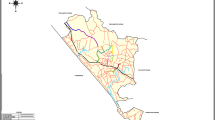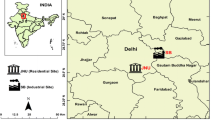Abstract
Plants can be used as both passive biomonitors and biomitigators in urban and industrial environments to indicate the environmental quality and to ameliorate pollution level in a locality. Many studies reveal that plants are negatively affected by the ambient levels of air pollutants. The present study was conducted to evaluate the impact of air pollution on comparative basis with reference to changes in photosynthetic pigments, plant height, leaves, as well as, biochemical parameters of plants of different sites around Udaipur city receiving varying levels of pollution load. The investigated tree species Dalbergia sissoo Roxb. (Family: Fabaceae) exhibited a reduction in various physiological and biochemical growth parameters that correspond with air pollution levels at different sites. The tree species growing in polluted and control areas were compared with respect to foliar dust load, leaf area, and chlorophyll and total carbohydrate and total protein concentration in the leaves. Our studies suggest that D. sissoo Roxb. can successfully be grown in an area for monitoring air pollution, where it is mild and droughts are common. It will prove as an ideal tree species to control pollution effectively beside acting as a shade tree and being a source of food for birds and animals. By plantation of D. sissoo Roxb., mitigative measure at the polluted sites to control generation of particulate matter and the air quality required can be ensured. Our results also confirm that industrial and vehicular air pollution level in Udaipur city is shifting beyond limits.











Similar content being viewed by others
References
Aftab, A., & Sakil, A. (2003). Study of sulfur accumulation on plant foliage due to coal smoke pollution. Geobios, 30, 284–285.
Agbaire, P. O. (2009). Air pollution tolerance indices of some plants around Erhoike–Kpkori oil exploration site of Delta state, Nigeria. International Journal of the Physical Sciences, 4, 366–368.
Agbaire, P. O., & Esiefarienrhe, E. (2009). Air pollution tolerance indices of some plants around Otorogun gas plant in Delta State, Nigeria. Journal of Applied Sciences & Environmental Management, 13, 11–14.
Alföldy, B., & Steib, R. (2011). Investigating the real air pollution exchange at urban sites based on time variation of columnar content of the components. Water, Air, and Soil Pollution, 220, 9–21.
Bamniya, B. R., Kapoor, C. S., & Kapoor, K. (2012). Searching for efficient sink for air pollutants—studies on Mangifera indica L. Clean Technologies and Environmental Policy, 14, 107–114.
Bamniya, B. R., Kapoor, C. S., Kapoor, K., & Kapasya, V. (2012). Harmful effects of air pollution on physiological activities of Pongamia pinnata (L.) Pierre. Clean Technologies and Environmental Policy, 14, 115–124.
Bamniya, B. R., Kapoor, C. S., Jain, S., & Kapoor, K. (2012). Impact assessment of air pollution in industrial areas of Rajasmand and Udaipur Districts. Journal of Environmental Science, Computer Science and Engineering & Technology, 1(3), 411–417.
Chaurasia, B., Mahajan, S., & Chauhan, S. V. S. (2002). Impact of automobile pollution on phenology and reproductive biology of Cassia siamea Lam. Indian Journal of Environmental Science, 6, 85–90.
Cox, R. M. (2003). The use of passive sampling to monitor forest exposure to O3, NO2 and SO2: a review and some case studies. Environmental Pollution, 126, 301–311.
Dineva, S. B. (2004). Comparative studies of the leaf morphology and structure of white ash Fraxinus americana L. and London plane tree Platanus acerifolia wild growing in polluted area. Dendrobiology, 52, 3–8.
Douwes, J., Thorne, P., Pearce, N., & Heederik, D. (2003). Review: Bio-aerosol health effects and exposure assessment: progress and prospects. The Annals of Occupational Hygiene, 47(3), 187–200.
Dubois, M., Gilles, K. A., Hamilton, J. K., Rebers, P. A., & Smith, F. (1956). A colorimetric method for the determination of sugars and related substances. Analytical Chemistry, 28, 350–356.
Escobedo, F. J., Wagner, J. E., & Nowak, D. J. (2008). Analyzing the cost effectiveness of Santiago, Chile’s policy of using urban forest to improve air quality. Journal of Environmental Management, 86, 148–157.
Govindaraju, M., Ganeshkumar, R. S., Suganthi, P., Muthukmaran, V. R., & Visvanathan, P. (2010). Impact assessment of air pollution stress on plants species through biochemical estimations. World Academy of Science & Engineering and Technology, 72, 935–938.
Griffiths, H. (2003). Air pollution on agricultural crops, Ministry of Agriculture, Food and Rural Affairs, Ontario. Fact Sheet, Order No. 85–002.
Honour, S. L., Bell, J. N., Ashenden, T. W., Cape, J. N., & Power, S. A. (2009). Responses of herbaceous plants to urban air pollution: effects on growth, phenology and leaf surface characteristics. Environmental Pollution, 157, 1279–1286.
Ilyas, S. Z., Khattak, A. I., Nasir, S. M., Qurashi, T., & Durrani, R. (2010). Air pollution assessment in urban areas and its impact on human health in the city of Quetta, Pakistan. Clean Technologies and Environmental Policy, 12, 291–299.
Jacobs, M. B., & Hochheiser, S. (1958). Continuous sampling and ultramicro determination of nitrogen dioxide in air. Analytical Chemistry, 30, 426–428.
Jenson, A. (1978). Chlorophylls and carotenoids. In J. A. Hellebust & J. S. Craigie (Eds.), Handbook of phycological methods (pp. 59–70). London: Cambridge University Press.
Joshi, N., & Bora, M. (2011). Impact of air quality on physiological attributes of certain plants. Reports and Opinion, 3(2), Marshland Press, Michigan, USA, pp. 42–47. (http://www.sciencepub.net/report).
Joshi, O. P., & Sikka, J. (2002). Floral response of some tree species to air pollution. Pollution Research, 21, 417–419.
Joshi, P. C., & Swami, A. (2007). Physiological responses of some tree species under roadside automobile pollution stress around city of Haridwar, India. Environmentalist, 27, 365–374.
Joshi, N., Chauhan, A., & Joshi, P. C. (2009). Impact of industrial air pollutants on some biochemical parameters and yield in wheat and mustard plants. Environmentalist, 29, 398–404.
Kapoor, C. S., Kapasya, V., Bamniya, B. R., & Kapoor, K. (2009a). Physiological and biochemical studies on some common tree species in Udaipur city under pollution stress. Journal of Current Sciences, 14(1), 181–186.
Kapoor, C. S., Kapasya, V., Bamniya, B. R., & Kapoor, K. (2009b). Studies on the quality of ambient air in the Udaipur city (Rajasthan). Journal of Current Sciences, 14(1), 187–192.
Kapoor, C. S., Bamniya, B. R., & Kapoor, K. (2012). Natural and effective control of air pollution through plants—studies on a tree species: Holoptelea integrifolia L. Mitigation and Adaptation Strategies for Global Change, 17, 793–803.
Li, M. H. (2003). Peroxidase and superoxide dismutase activities in fig leaves in response to ambient air pollution in a sub-tropical city. Archives of Environmental Contamination and Toxicology, 45, 168–176.
Liu, Y. J., & Ding, H. (2008). Variation in air pollution tolerance index of plants near a steel factory: implication for landscape–plant species selection for industrial areas. WSEAS Transactions on Environment and Development, 4, 24–32.
Lowry, O. H., Rosebrough, N. J., Farr, A. L., & Randal, R. J. (1951). Protein measurement with the Folin-phenol reagent. Journal of Biological Chemistry, 193, 265–275.
Mahadevan, A., & Sridhar, R. (1982). Methods in physiological plant pathology (IIth ed., pp. 157–159). Madras: Sivakami Publications.
Nandeswar, D. L., & Banerjee, S. K. (2002). Impact of open-cast mining pollutants on vegetation at Bisrampur colliery of M.P. Advances in Forestry Research in India, 21, 1–21.
Nithamathi, C. P., & Indira, V. (2005). Impact of air pollution on Ceasalpinia sepiaria Linn. In Tuticorin city. Indian Journal of Environment and Ecoplanning, 10(2), 449–452.
Pandey, J., & Sharma, M. (2003). Environmental Sciences. Bikaner, India: Yash Publications. 90 pp.
Panichev, N., & Crindle, M. (2004). The application of bioindicators for assessment of air pollution. Journal of Environmental Monitoring, 6, 121–123.
Prajapati, S. K., & Tripathi, B. D. (2008). Anticipated performance index of some tree species considered for green belt development in and around an urban area: a case study of Varanasi city, India. Journal of Environmental Management, 88, 1343–1349.
Rai, A., Kulshreshtha, K., Srivastava, P. K., & Mohanty, C. S. (2010). Leaf surface structure alterations due to particulate pollution in some common plants. Environmentalist, 30, 18–23.
Rehme, K. A., Smith, C. F., Fitizsimmons, M. I. (1984). Investigation for use in the determination of ambient particulate matter. Research Triangle Park NC, pp. 048.
Ribas, A., & Penulas, J. (2003). Biomonotoring of tropospheric ozone phytotoxicity in rural Catalonia. Atmosphere and Environment, 37, 63–71.
Seeyeednejad, S. M., & Koochak, H. (2011). A study on air pollution-induced biochemical alterations in Eucalyptus camaldulensis. Australian Journal of Basic and Applied Sciences, 5(3), 601–606.
Seeyeednejad, S. M., Niknejad, M., & Yusefi, M. (2009a). Study of air pollution effects on some physiology and morphology factors of Albizia lebbeck in high temperature condition in Khuzestan. Journal of Plant Sciences, 4, 122–126.
Seeyeednejad, S. M., Niknejad, M., & Yusefi, M. (2009b). The effect of air pollution on some morphological and biochemical factors of Callistemon citrinus in petrochemical zone in south of Iran. Asian Journal of Plant Sciences, 8, 562.
Seeyeednejad, S. M., Niknejad, M., & Koochak, H. (2011). A review of some different effect of air pollution on plants. Research Journal of Environmental Sciences, 5(4), 302–309.
Shamim, A., Siddiqui, A., & Khan, S. (2002). Genotoxic effects of smoke as a pollutant on Cestrum diurnum Linn. Advances in Plant Sciences, 15, 573–577.
Sharma, A. P., & Tripathi, B. D. (2009). Biochemical responses in tree foliage exposed to coal-fired power plant emission in seasonally dry tropical environment. Environmental Monitoring and Assessment, 158, 197–212.
Sulistijorini, et al. (2008). Tolerance levels of roadside tress to air pollutants based on relative growth rate and air pollution tolerance index. Hayati Journal of Biosciences, 15(3), 123–129.
Tiwari, S., Agrawal, M., & Marshall, F. M. (2006). Evaluation of ambient air pollution impact on carrot plants at a sub urban site using open top open chambers. Environmental Monitoring and Assessment, 199, 15–30.
Verma, M., Agrawal, M., & Deepika, S. S. (2000). Interactive effects of sulphur dioxide and mineral nutrients supply on photosynthetic characteristics and yield of four wheat cultivars. Photosynthetica, 38(1), 91–96.
West, P. W., & Gaeke, G. C. (1956). Fixation of sulphur dioxide as disulfitomercurate and subsequent colorimetric determination. Analytical Chemistry, 28, 1816–1819.
Woo, S. Y., Lee, D. K., & Lee, Y. K. (2007). Net photosynthetic rate, ascorbate peroxide and glutathione reductase activities of Erythrina orientalis in polluted and non-polluted areas. Photosynthetica, 45, 293–295.
Yan-Ju, L., & Hui, D. (2008). Variation in air pollution tolerance index of plant near a steel factory; implications for landscape-plant species selection for industrial areas. Environment and Development, 1(4), 24–30.
Author information
Authors and Affiliations
Corresponding author
Rights and permissions
About this article
Cite this article
Kapoor, C.S., Bamniya, B.R. & Kapoor, K. Efficient control of air pollution through plants, a cost-effective alternative: studies on Dalbergia sissoo Roxb. Environ Monit Assess 185, 7565–7580 (2013). https://doi.org/10.1007/s10661-013-3119-1
Received:
Accepted:
Published:
Issue Date:
DOI: https://doi.org/10.1007/s10661-013-3119-1




